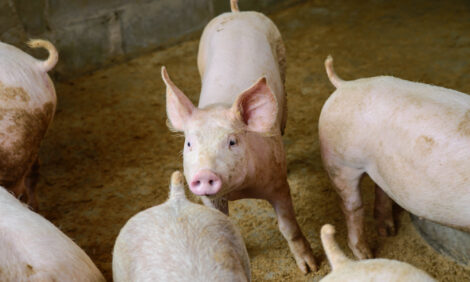|
Need a Product or service?
|
|

Ron Plain |
The December 1 Hogs and Pigs Report came in a little more positive than our estimate but more negative than the average of the trade estimates. The total herd was up 1%, the breeding herd down 1%, and the market herd up 1% compared to 12 months earlier.
The breeding herd came in at our estimate of 99% and is consistent with our gilt and sow slaughter data.
This report is clearly not what hog producers need. Our current estimate is for a 102.3 million head slaughter for 2004 which, if it comes true, will be a new record high in number of hogs slaughtered in the U.S. We do not expect any problems with slaughter capacity unless we lose a large packing plant.
The 180 lb. and heavier market inventories for December are consistent with December slaughter.
The September-November pig crop was up 1.7% and the under 60 lb. inventory was up 1.9%. The extra 0.2% increase in this weight group is too small to cover all the increase in feeder pig imports from Canada in October and November.
Demand for pork for January-November at the consumer level was down a little. However, demand for these 11 months for live hogs was up about 1.6% due to narrower marketing margins, according to USDA data. We believe the retail or consumer demand may be stronger than indicated by the data because of pumping some pork products which adds to sale weight and contributes to more pounds of product sold at retail than believed.
We are building some potential weakness in demand into our estimates of prices for 2004, in part because of the likely lower beef prices due to finding the cow in Washington state with BSE in late December.
Productivity growth in the fourth quarter of 2003 appears to have been quite robust. The breeding herd on September 1 was down about 2.5% but farrowings were up 0.7% from a year earlier. Litter size was also up 1.1% for September-November compared to a year earlier. This adds up to a growth in productivity of over 4% without including the heavier carcass weights likely for these hogs. In our opinion, productivity growth in the hog industry is likely to continue for some time.
We expect hog slaughter for the first quarter of 2004 to be up about 1.5% from a year earlier on a daily basis. Some of the increase is expected to result from more slaughter hog imports from Canada. For the second quarter of 2004 we are estimating an increase of about 2.5% from the same quarter of 2003. Again, a portion of the expected increase will be due to more slaughter hogs coming from Canada. Our third quarter estimate for a 2% increase in slaughter compared to 12 months earlier is based on productivity growth as indicated by the first quarter farrowing intentions. First quarter farrowing intentions indicate a 1% larger farrow with a 1% smaller breeding herd on December 1.
Hog producers, on average, received a higher hog price than most of us expected based on the negotiated hog prices. The average net price received for non-packer-sold hogs in 2003 was about $55.25 per 100 lbs. of carcass or about $40.89 per 100 lbs. live weight. These average net prices came from the mandatory price reporting data. We have added the net carcass price for non-packer-sold hogs to our quarterly price estimates in Table 4.
The most recent data available will not support the possibility that producers are reducing the breeding herd. Our gilt slaughter data for recent months is running below a year earlier. Therefore, unless producers start to cull more sows or hold fewer gilts, the March 1 breeding herd is likely to be as large as a year earlier and could be a little larger.
Hopefully, this report will be a wake-up call to hog producers. If all hog producers would sell the least productive 5% of their breeding herds in the next few weeks, it would add substantially to hog prices in late 2004.
For hog producers with above-average costs of production, the probabilities are high for losses on average for the next several years.
With productivity growth at 2% for the next several years, supplies will keep growing faster than demand unless producers start reducing the breeding herd more than currently indicated.
Pork exports for January through October 2003 were up 6.4% from 12 months earlier. Therefore, pork exports are highly likely to set a new record high for the 12th consecutive year. The bad news about trade is that our net export of pork declined in 2003 because pork imports increased more than pork exports.
Our estimates of slaughter and prices by quarter are in Table 4.
Table 1. Hog Inventories June 1, U.S.
______________________________________________________________
2003 as % of 2002
Market 101
Kept for breeding 99
All hogs and pigs 101
______________________________________________________________
Table 2. Market Hogs on Farms June 1, U.S.
_____________________________________________________________
Weight Category 2003 as % of 2002
Under 60 pounds 102
60 - 119 pounds 102
120 - 179 pounds 100
180 pounds and over 101
_____________________________________________________________
Table 3. Sows Farrowing and Intentions, U.S.
_____________________________________________________________
2003 as % of 2002
June-August 98
September-November 101
2004 as % of 2003
December-February 101
March-May 99
______________________________________________________________
Table 4. Estimated Commercial Hog Slaughter by Quarter and
Live Hog Prices 1998-2004
____________________________________________________________________
Commercial Terminal Mkt. 51-52% Lean Non-packer-sold
Slaughter Barrow & Gilt Hogs Hogs (avg. net
Period (mil. hd.) (price/cwt.) (price/cwt.) carcass price/cwt)
___________________________________________________________________________
1998 1 24.776 $34.74
2 23.628 39.42
3 25.039 33.62
4 27.586 19.49
Year 101.029 31.82
1999 1 25.579 $26.55 $28.83
2 24.288 33.06 35.18
3 24.953 32.78 35.70
4 26.724 33.88 36.29
Year 101.544 31.57 34.01
2000 1 25.039 $39.11 $41.14
2 23.125 47.99 50.43
3 24.097 44.19 46.44
4 25.715 38.33 40.78
Year 97.976 42.41 44.70
2001 1 24.578 $40.77 $42.83
2 23.280 50.21 52.05
3 23.635 48.04 51.05
4 26.469 34.97 37.30 $51.67
Year 97.962 43.50 45.81 n/a
2002 1 24.148 $37.23 $39.43 $54.25
2 24.280 32.77 34.99 50.43
3 25.120 31.09 33.86 49.66
4 26.715 28.52 31.34 46.10
Year 100.263 32.40 34.91 50.11
2003 1 24.620 $33.32 $35.38 $50.40
2 23.890 39.86 42.64 58.92
3 24.698 38.66 42.90 59.27
4 (part. est.) 27.515 34.57 37.10 52.40
Year(part. est.)100.723 36.60 39.51 55.25
2004 1 (projected) 25.400 $33 - 36 $36 - 39 $51 - 55
2 (projected) 24.490 36 - 39 39 - 42 54 - 58
3 (projected) 25.200 35 - 38 38 - 41 53 - 57
4 (projected) 27.200 29 - 32 32 - 35 45 - 49
Year (proj.) 102.290 33 - 36 36 - 39 51 - 55
____________________________________________________________________
|


















